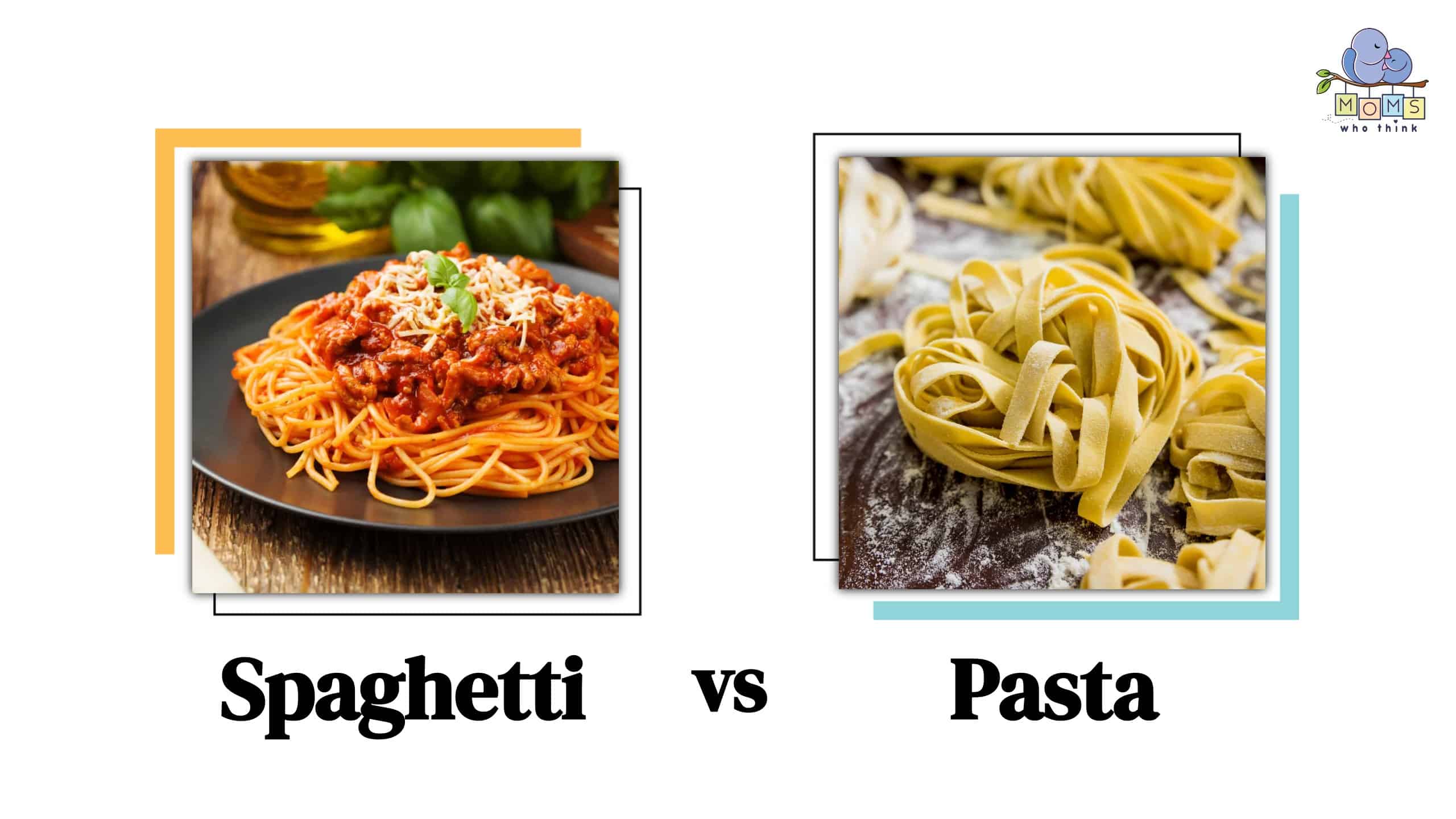While spaghetti is a type of pasta, not all pasta is spaghetti. Both are made from a mixture of durum wheat flour and water. Pasta in general is the form in which it has been shaped, whereas spaghetti is a type of pasta that is long and thin like a noodle. Understanding the differences between spaghetti vs. pasta, their origins, nutritional value, and cooking techniques, can help you make an informed decision about what to eat and how to prepare it. Whether you are a fan of Italian cuisine or simply looking to expand your culinary knowledge, this article will provide you with a deeper understanding of these two iconic foods.
- The must-have convenient reference guide for every home cook!
- Includes more than 8,000 substitutions for ingredients, cookware, and techniques.
- Save time and money on by avoiding trips to grab that "missing" ingredient you don't really need.
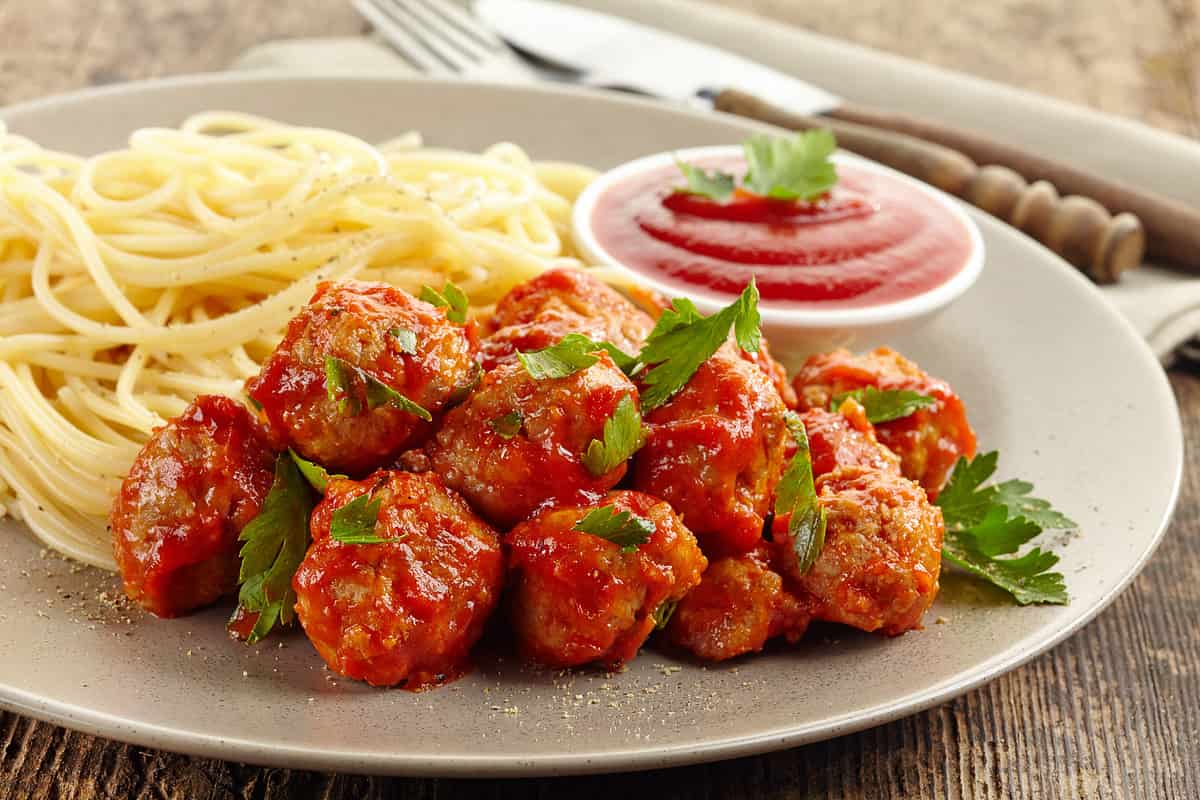
©iStock.com/Magone
What is Spaghetti?
Spaghetti is a long, thin, cylindrical-shaped pasta. It is one of the most commonly known and popular types of pasta because of its distinct shape and versatility. Spaghetti can be found in various forms, such as regular or whole grain, and made from wheat, quinoa, or buckwheat. It is usually served with tomato-based sauces and meatballs.
What is Pasta?
Pasta is an Italian term that encompasses a wide range of different types of noodles. The term ‘pasta' in Italian refers to any dough made from flour, water, and sometimes eggs. Pasta comes in different shapes and sizes, like penne, rigatoni, fettuccine, and many more.
Origins of Spaghetti and Pasta
Spaghetti originated in southern Italy in the 19th century by the Arabs, and then the Italians created their own version, which is spaghetti.
The exact origin of pasta is unclear, but it is widely believed to have originated in China. It is that Marco Polo brought pasta to Italy from China, and it was then developed and popularized by the Italians.
The Role of Spaghetti and Pasta in Italian Culture
Pasta and spaghetti play a significant role in Italian culture, and they are a staple food in Italian cuisine. Italians have created and perfected countless pasta dishes, such as spaghetti carbonara, spaghetti bolognese, and lasagne, which have become popular worldwide.
Nutritional Value and Health Benefits of Spaghetti and Pasta
Spaghetti and pasta are both good sources of carbohydrates, which provide energy for the body. They are also high in fiber, which aids digestion and helps to lower cholesterol levels. Additionally, pasta made from whole-grain can provide more nutrients and health benefits.
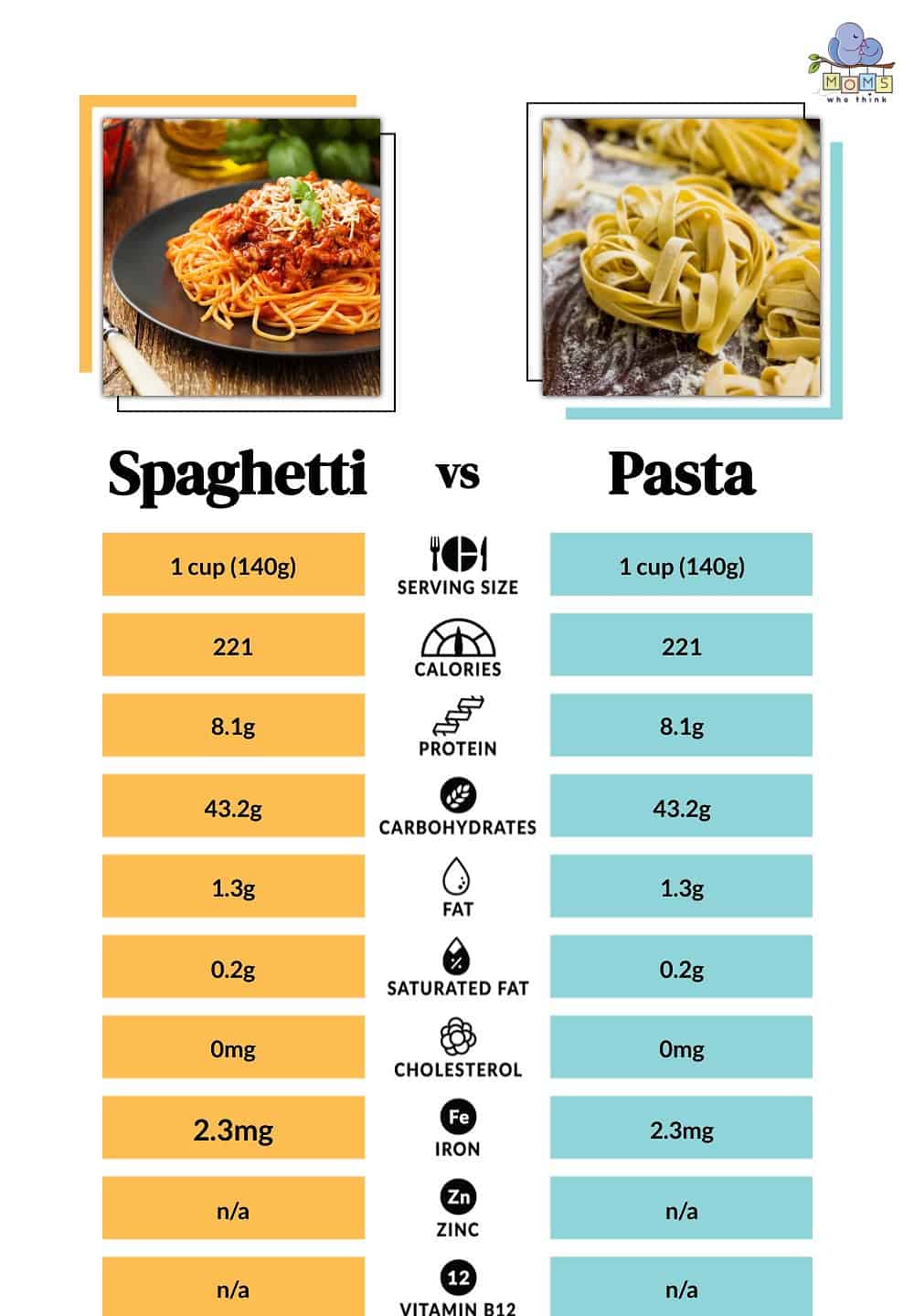
How to Cook Spaghetti and Pasta
Alright, let’s talk about how to cook the perfect pot of spaghetti or pasta. First, grab a large pot and fill it with water and a decent pinch of salt, cover it with a lid, and allow it to boil. Next, add your pasta and stir occasionally to prevent it from clumping. Cook until the pasta is al dente for about 8-12 minutes depending on the type used. Then drain the pasta in a colander. To keep spaghetti and pasta from sticking together, add a little oil or butter to the pasta after draining. Finally serve it with your favorite sauce, a side salad, or crusty bread.
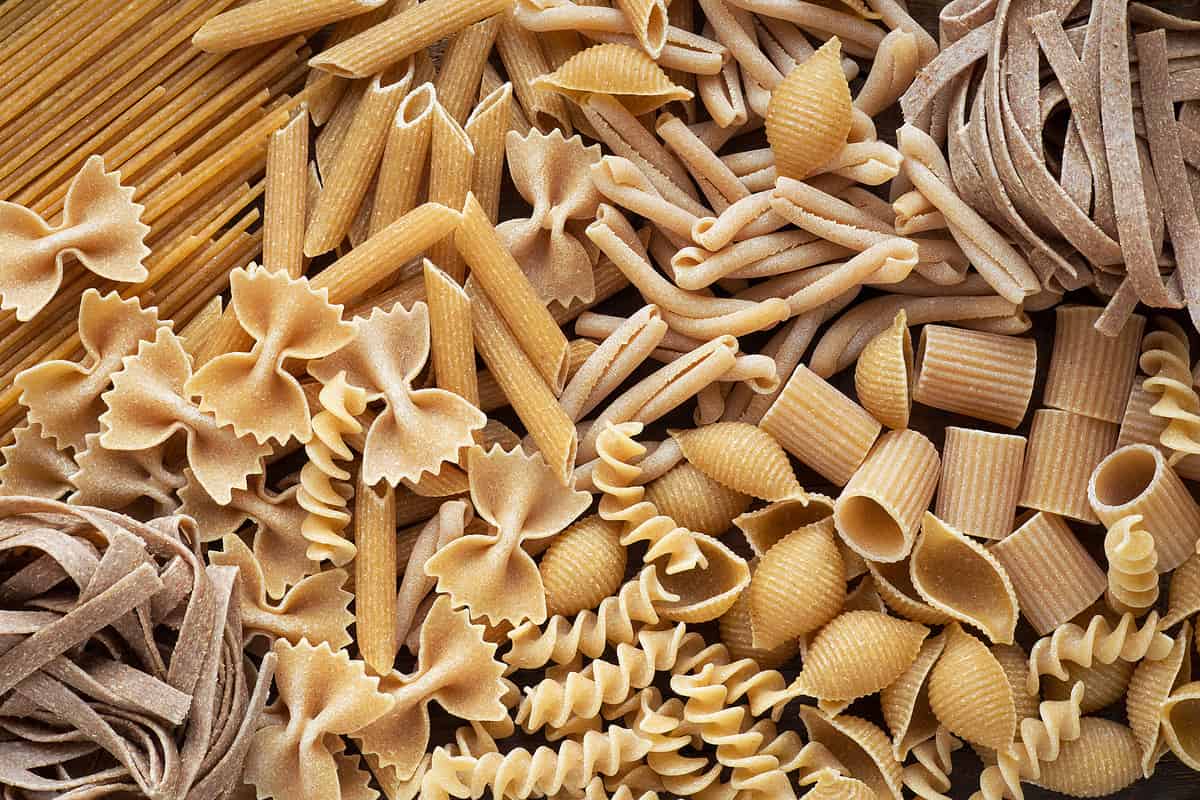
©iStock.com/Kuvona
Making Friends With Pasta
Pasta can make entertaining guests a pleasure. In Italy, a common invitation is ‘Why don’t you come over for a “spaghettata”?’ A ‘spaghettata’ means joining your friends for a bowl of pasta and a nice glass of wine. The classic ‘spaghettata’ is quickly served with a tomato-based sauce, herbs, and garlic.
- The must-have convenient reference guide for every home cook!
- Includes more than 8,000 substitutions for ingredients, cookware, and techniques.
- Save time and money on by avoiding trips to grab that "missing" ingredient you don't really need.
10 Popular Sauces for Spaghetti Dishes
When it comes to popular spaghetti and pasta sauces, the options are endless. The first sauce that comes to mind is marina or bolognese. Spaghetti and pasta can be paired with ingredients ranging from meat to vegetables and seafood. Chicken and beef are great choices for meat lovers, while mushrooms and spinach are perfect for vegetarians. Adding shrimp or clams can turn your spaghetti or pasta into a delicious seafood dish.
Let’s take a closer look at some delicious spaghetti sauce alternatives which can help inspire you.
- Loose-Lady style sauce: canned tomatoes, garlic, black olives, capers, anchovy fillets, olive oil, chili, salt, tomato purée, and parsley.
- Genoese paste: fresh basil and mint, garlic, pine kernels, chopped almonds or walnuts, pecorino cheese, and olive oil.
- Alla Checca: ripe tomatoes, green olives, fresh basil, parsley, olive oil, fennel seeds salt, and pepper.
- Aglio Olio: olive oil, garlic, green chili, and parsley.
- Truffle sauce: black truffles, anchovy fillets, olive oil, and parsley.
- Amatrice sauce: onion, streaky bacon, canned tomatoes, olive oil, chili, tomato purée, pecorino, or romano cheese.
- Chicken liver sauce: chicken livers, onion, olive oil, salt, dry white wine, butter, and parmesan cheese.
- Rabbit sauce: skinned rabbit, dry white wine, canned tomatoes, garlic, olive oil, chili, tomato purée, salt, and parmesan cheese.
- Casserole sauce: button mushrooms, butter, minced lean beef, pepper, dry white wine, and parmesan cheese.
- Fisherman’s sauce: your choice of seafood for example, prawns, clams, mussels, squid, baby octopus, cuttlefish, olive oil, chili, salt, parsley, garlic, and canned tomatoes.
10 Popular Sauces for Pasta Dishes
Pasta comes in many different shapes in this example we will list 10 popular sauces for penne pasta.
- Hot-Tempered sauce: canned tomatoes, garlic, olive oil, green chili, salt, and parsley.
- Asparagus sauce: asparagus, salt, butter, and parmesan cheese.
- Aubergine sauce: aubergines, mozzarella cheese, canned tomatoes, garlic, olive oil, salt, and parmesan cheese.
- Al Sedano ed altre cose: dried mushrooms, onion, celery, Italian-style spicy sausages, bay leaves, butter, dry white wine, flour, milk, salt, marjoram, nutmeg, and parmesan cheese.
- Springtime sauce: parsley, streaky bacon, onion, carrot, celery, butter, peas, ripe tomatoes, courgette, mushrooms, stock, salt, pepper, and parmesan cheese.
- Ragoût sauce with beef rolls: canned tomatoes, onion, garlic, parsley, beef or rump steak, olive oil, dry white wine, tomato purée, salt, parmesan cheese, and wooden cocktail sticks.
- Norcia sauce: onion, olive oil, chili, spicy Italian sausage meat, dry white wine, cream, salt, butter, and parmesan cheese.
- Wood-Cutter’s sauce: ripe tomatoes, mushrooms, onion, streaky bacon, olive oil, black pepper, and parmesan cheese.
- Calabrian sauce: canned tomatoes, garlic, olive oil, chili, Calabrese salami, and pecorino cheese.
- Caviar sauce: butter, cream, caviar, salt, and pepper.
Final Thoughts Between Spaghetti and Pasta
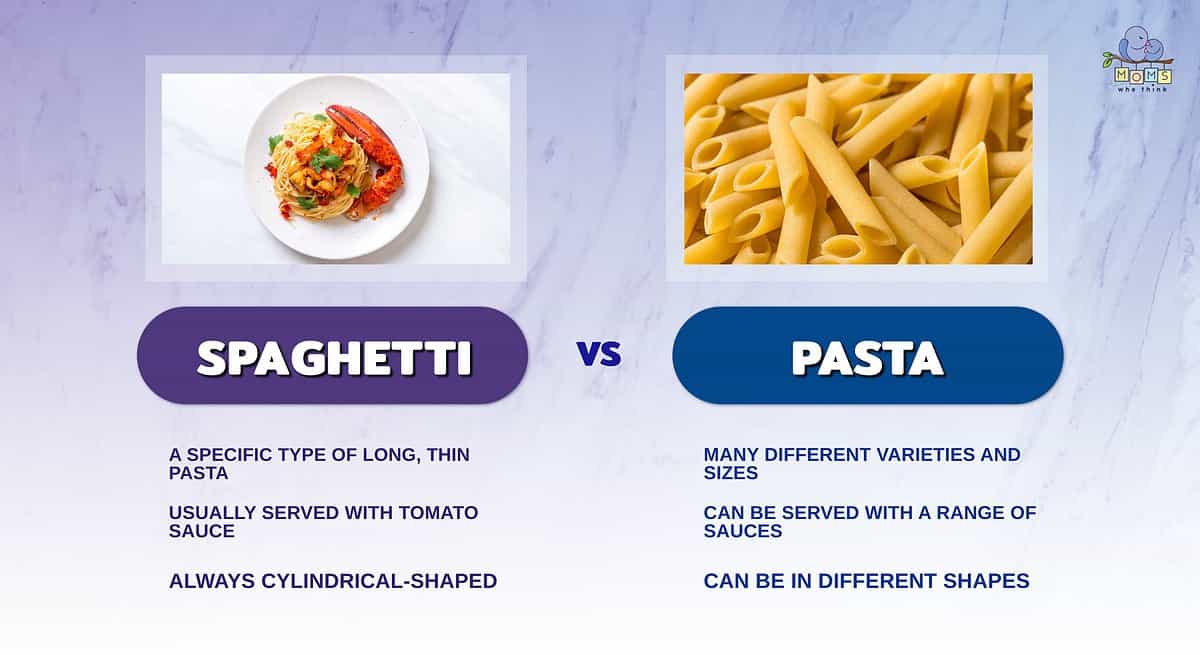
- Spaghetti is a specific type of long, thin pasta. It's important not to confuse it with similarly-shaped pasta, like angel hair. The difference is in the thickness.
- Pasta can be served with a range of sauces, like alfredo sauce. Spaghetti can be served with other sauces as well, but is most commonly paired with tomato sauce.
- Spaghetti is always cylindrical, while other pastas can be a variety of shapes.
Additionally, spaghetti is generally more filling than pasta, as it contains more carbohydrates. While pasta is also considered a filling food, it is lighter and lower in calories than spaghetti. The decision between spaghetti vs. pasta ultimately comes down to personal preference. If you're looking for a classic Italian dish with a chewy texture and a variety of sauces, spaghetti is a great choice. If you're looking for a lighter dish with more variety, pasta is the way to go. Whichever option you choose, you'll be sure to enjoy a delicious meal.
FAQ
What is the nutritional difference between spaghetti and pasta?
The nutritional value of spaghetti and pasta can vary depending on the type of flour, ingredients, and cooking methods used. Generally, spaghetti and pasta are both low in fat and calories and are good sources of complex carbohydrates. However, some types of pasta may contain more fiber and protein than spaghetti, while others may have higher levels of vitamins and minerals.
What are some popular pasta and spaghetti dishes?
There are countless delicious and popular pasta and spaghetti dishes, ranging from simple and classic to complex and gourmet. Some of the most popular spaghetti dishes include spaghetti carbonara, spaghetti bolognese, and spaghetti alle vongole. Popular pasta dishes include fettuccine alfredo, lasagne, and penne arrabbiata. However, there are many other variations and recipes depending on the region.
What is the difference between fresh pasta and dried pasta?
Fresh pasta is made with flour, eggs, and water and is often softer and more delicate than dried pasta. Fresh pasta can be used in a wide range of dishes, from lasagna to ravioli, and can be stored in the refrigerator or freezer for later use. Dried pasta, on the other hand, is made with durum wheat flour and water and is typically firmer and more durable than fresh pasta. Dried pasta can be cooked in boiling water and is ideal for recipes that require a firmer texture, such as spaghetti carbonara or penne all'arrabbiata.
Spaghetti and Pasta Recipes
Print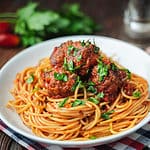
Easy Spaghetti and Meatballs
- Total Time: 15 minutes
Ingredients
- 1 pound ground beef
- 2 Tablespoons water
- 1/3 seasoned dry bread crumbs
- 1 egg, beaten
- 24 ounces (1 jar) Italian spaghetti sauce
- 8 ounces spaghetti, Cooked and drained
Instructions
1. Mix thoroughly ground beef, water, bread crumbs and egg.
2. Shape firmly into 12 (2-inch) meatballs. Arrange the meatballs in a 2-quart microwavable baking dish.
3. Microwave on HIGH for 5 minutes or until they're Cooked through. Drain excess fat.
4. Stir the sauce into the dish. Cover.
5. Microwave for 3 minutes or until hot. Serve over the spaghetti.
- Prep Time: 5 minutes
- Cook Time: 10 minutes
